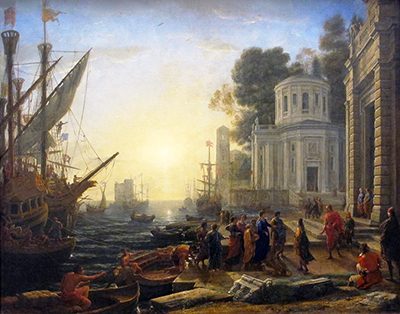The Disembarkation of Cleopatra at Tarsus was constructed by Claude Lorrain in 1642. This large artwork is nearly two metres in width and can today be found at the Louvre in Paris, France.
The content is categorised as history painting, and the theme of the work is predominantly delivered by a series of figures in the foreground. Claude was happiest when producing landscape scenes and these dominate his oeuvre but in order to deliver certain themes with a religious or mythological connection he would also include other details within each composition. Most of his paintings would use a traditional landscape as the backdrop but a few would be more seascape-focused. The Disembarkation of Cleopatra at Tarsus does just that, with a flickering sea drifting off into the distance. Claude was a true master of the use of light within his paintings and we see that here in how the sun reflects down towards us. He also liked to include classical architecture and we find that on the right hand side of this port scene. Several tall buildings provide a vertical balance to the painting, with further trees and shrubs placed just behind. The sky above is bright, with just a few clouds at the very top of the artwork.
The main content is to be found close by, with a large ship to the left hand side. There are also many figures on the harbour, looking out to see. Many small boats are then moored up across the harbour, some of which have fishermen and others figures onboard. The artist then includes ships further in the distance as a means to producing perspective, which normally he would achieve through other natural additions such as trees and mountains. The clothing on these figures immediately places us within classical times, and we refer to the title of the piece for further guidance as to what we are observing. Tarsusis known as the ancient city where Cleopatra met Mark Antony. Claude chose to depict this location to signify her disembarkment within this scene, with many others joining the occasion on the shore. The artist was skilled in seascapes and depicting tall ships, meaning this topic would suit a style that he was already comfortable with.
He produced many mythologically based scenes across his career and was regularly asked to create them for a number of different patrons. He lived most of his life in Italy and built up a strong following in the city of Rome. He counted some illustrious names on his list of patrons at the height of his fame and was able to acquire customers from other parts of Europe without necessarily visiting these locations himself. His oeuvre is therefore highly interesting, in how he brought landscape art to the masses for perhaps the first time, but was sufficiently involved with history painting that he could appeal to enough patrons to make his career financially viable. He remains regarded as a truly influential artist who inspired a whole host of names from the next few centuries.




